The golden age of Twitter is over
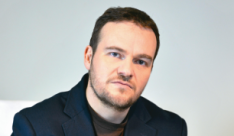 The spam, the analytics, and the lack of human interaction all suggest the same thing – Twitter’s golden age is behind it, argues Mumbrella’s Tim Burrowes.
The spam, the analytics, and the lack of human interaction all suggest the same thing – Twitter’s golden age is behind it, argues Mumbrella’s Tim Burrowes.
My life was so different in 2008.
Back on Wednesday September 10, at 7.18pm, I was stuck in an ugly office block in Chatswood.
I think it must have been my last week as editor of B&T. We were sending the mag to press and we were, as usual, running late.
I know that now, because that was when I decided to join Twitter, so my first tweet is still there.
And like most people’s first tweet, it was mundane. Seven years on, quite deservedly, it’s never had a retweet or a like:
“sending the mag to press”
It was as self conscious and self referential as everyone’s first tweet always is.
sending the mag to press
— Tim Burrowes (@mumbrella) September 10, 2008
I wasn’t to realise, but I was embarking upon something of a love affair.
In the intense months, and even years, that followed, Twitter was to become a big part of my life.
For me, it was to help create a business, make new friends and enhance my digital life.
I really loved Twitter.
But I fear I’ve developed the seven year itch.
These days, it’s merely a useful tool, and at that a tool that I no longer get excited about.
It was all so different when Twitter broke through though.
I was lucky that it coincided with the launch of Mumbrella. Our audience were exactly the sort of people who would be early adopters.
Twitter became a topic to write about; a means of connecting with our audience in the real world; and, of course, a huge traffic driver.
When Social Media Club Sydney launched in 2009, it might as well have been called Twitter Club. And it was all three of those things I just mentioned.
Our news story about the launch of #SMCSYD became a great news topic for Mumbrella from the off, with controversy about whether it would become a platform for careerists. (That was before the phrase “social media guru” was popular.)
Meanwhile, that first #SMSYD event itself was electrifying. The tickets sold out within hours of going on sale. I wasn’t directly involved in organising it, but I did moderate the Q&A.
Two or three hundreds people packed the bar venue on Sydney’s Oxford Street and spilled onto another floor to watch it relayed on video. Here’s a photo tweeted at the time by Heather Ann Snodgrass of what it looked like from the stage:
I interviewed Adam Ferrier about his then agency Naked’s hoax on the press in which “Heidi” launched a hunt for the man who had left his Witchery jacket behind in a cafe.
And then I chatted to Leslie Nasser about his Fake Stephen Conroy Twitter persona.
It all felt so new.
And it kept growing.
A few weeks later we filled a lecture hall at UTS to hear from MC Hammer about his social media profile. Yes, MC Hammer – it seems a bit surreal now.
https://www.youtube.com/watch?v=xigCJOcXyQs
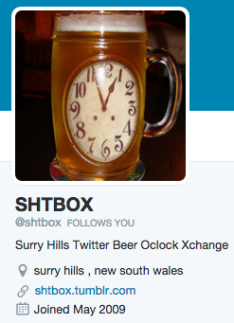 And if that wasn’t enough real world social media, every Friday night, The Clock in Surry Hills became the home of #SHTBOX (pronounced “shitbox”, but standing for “Surry Hills Beer Exchange”) where Sydney’s social media gang used to hang out. I made a lot of friends there.
And if that wasn’t enough real world social media, every Friday night, The Clock in Surry Hills became the home of #SHTBOX (pronounced “shitbox”, but standing for “Surry Hills Beer Exchange”) where Sydney’s social media gang used to hang out. I made a lot of friends there.
But soon the real world part began to break down. There were fallings out and splinter groups. Briefly, some of the #SMCSYD gang launched Digital Citizens as a breakaway organisation..
And in the digital world, Twitter was going mainstream. And there wasn’t much point getting together in pubs to talk about it.
Social Media Club and Digital Citizens gradually fizzled out.
#SHTBOX kept going for a little longer, dropping from weekly, to monthly, and eventually ending altogether. I didn’t make it to the reunion in 2014.
In the digital world though, Twitter was driving Mumbrella’s audiences.
As a proportion of our social media traffic, it was the most important – far more so in those early days than Facebook.
Vitally, it drove people to our comment thread. So by the time our daily email went out to our wider audience, the conversation was already humming.
Looking at our Google analytics, Twitter (on the Google Analytics pie chat below in green) was driving more than two-thirds of our social traffic in 2009.
The next year, Twitter was still massive for us – driving 60%, even as Facebook began to become significant.
And even in 2011, Twitter was still our biggest social referral engine, driving more than 40% of that traffic, ahead of Facebook (in dark blue). That was also the year of peak Reddit for us, as it happens.
But in 2012, there was a brief changing of the guard. Facebook narrowly overtook Twitter as our biggest social referral site.
Then in 2013, for us at least, Twitter was to go through a brief resurgence. It pushed back past Facebook and drove half of Mumbrella’s social traffic.
But by then, the conversation was moving to Facebook. In 2014 it surged to driving more than 55% of our social audience ,while Twitter dropped back to just over a third.
Last year, the trend accelerated. Twitter fell to just over 20% of our social traffic, while Facebook claimed nearly 70%. LinkedIn rose to 7%.
And in these early days of 2016, the trend has continued. So far this year, Facebook has driven 77% of our social traffic, while Twitter has given us just 13%. LinkedIn has also risen again.
Looking at the trends, it wouldn’t surprise me if, by the end of this year, we’re getting more social traffic from LinkedIn than we are from Twitter.
All of this, of course, has come against the backdrop of growing traffic number for Mumbrella across the board, so it wasn’t until 2014 that Twitter declined for us in actual numbers.
Deep down, I’ve known it was going that way for a little while.
And I’m aware that I’m sounding a bit like a hipster complaining about how the first album was better when the band was still underground.
Those early days felt a bit like discovering a hot new bar or cafe ahead of the crowd. Everything – and everyone – was exciting.
Then it became a bit more like a loud nightclub. It was popular, and you could still have a lot of fun.
But in recent months, Twitter has begun to feel more like that experience you have in a shopping centre when the person on the teeth whitening stand tries to get you to stop, as you scurry past.
The ratio of spammers to real people has become annoyingly high.
Last year, I noticed a sudden jump in the number of followers my @mumbrella account was getting. When I looked at the types of followers, the ego boost didn’t last long.
I was paranoid because a few weeks before, newsletter Crikey had suggested The Australian’s media writer Darren Davidson might have bought himself some fake followers to boost his numbers. I feared somebody was setting me up to look like I was buying followers too.
So, using ManageFlitter, I did a mass cull of about 12,000 suspicious followers -those without a profile image, who had never tweeted, or only posted spammy messages.
Since then, I’ve watched more carefully as new followers accumulate.
It feels like the spammers now vastly outnumber the authentic voices.
Last week, I tried an exercise.
I examined my most recent 100 followers.
I quickly concluded 55 of them were obvious spam accounts.
Another 14, I just couldn’t tell – they hadn’t yet tweeted anything, but could simply have been new to the platform.
Being very generous, I concluded that the other 31 were probably real people, although I was only certain with about half of those.
The same goes, when you try following new people, which is something I’ve also been making a point of doing.
The result is an incessant drizzle of grubby direct messages to my inbox. At best mildly spammy, but often offering porn links.
On the occasions where a real person DMs me, I often miss it in the spam drizzle.
In part, my experience is not the same as everyone. Having started early, I’ve got 95,000 so-called followers. And in turn, I follow nearly 30,000, all of whom I’ve gradually added manually over the last seven years.
So of course, the signal is at greater risk of getting lost in the noise. And their are third party apps including TweetDeck that help with that.
But the problem for Twitter is that there’s now just so much noise.
Twitter has been trying – it recently began to introduce a “quality filter” to try to cut down on trolls.
And it’s been rolling out new initiatives.
Video service Periscope is now embedded directly in to the tweetstream.
Admittedly, that feels a little late though. The time would have been when everybody was madly experimenting with on air broadcasts via Google Hangouts.
And Facebook got there earlier too, including with its recent move into live video.
Twitter is still fighting for a future though.
I remain open minded about Twitter Moments, which launched in the US late last year. Effectively this offers a curated “best of Twitter” experience. I can see that it stands a chance of improving engagement.
But Twitter is no longer a competitor to Facebook. It has a different role now.
After the brief rise and fall of TV companion apps, Twitter remains the ultimate TV companion app.
Hashtag TV viewing, including for live sport, is fun and efficient. These days, it’s the only time, I feel like I’m having real conversations on Twitter.
Imagine trying to watch Q&A on the ABC without being able to follow the snark via the hashtag.
This alone will probably save Twitter from the same fate as social network predecessors like MySpace.
But it’s always a bittersweet experience. I preferred the first album.
Tim Burrowes is content director of Mumbrella. You can follow him on Twitter @mumbrella.

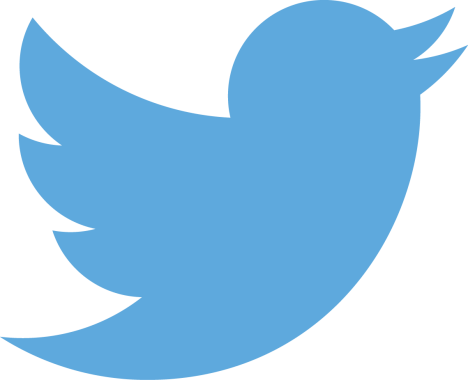
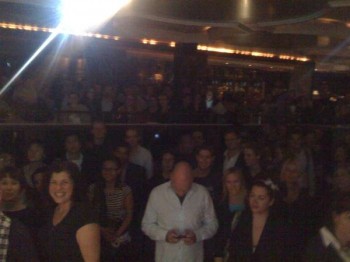
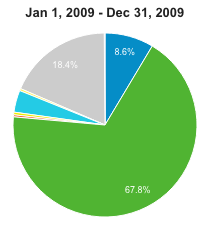

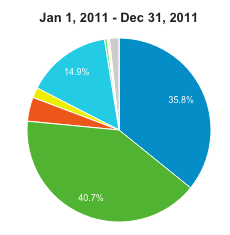
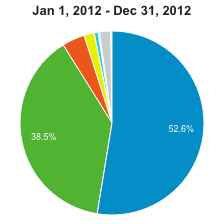
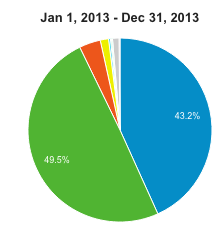
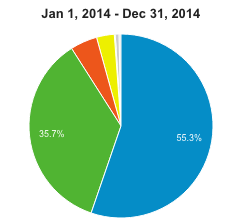
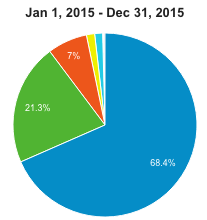
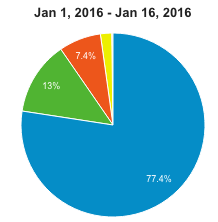
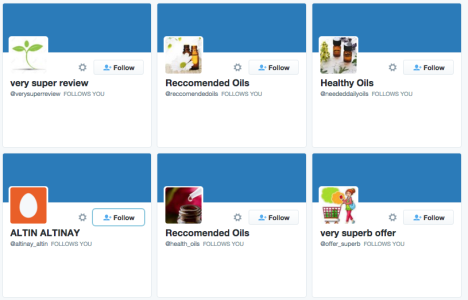
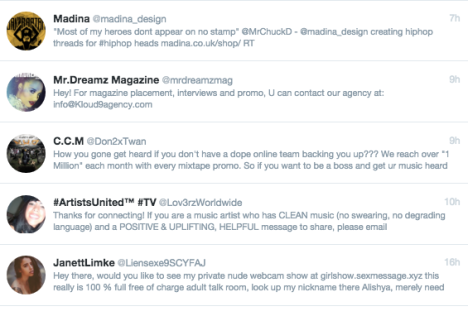
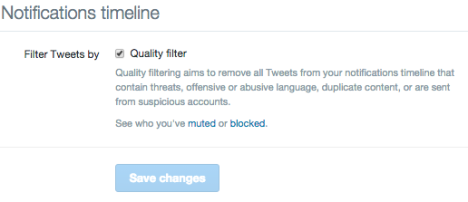

One can only assume this was drafted before yesterday’s announcement of Facebook’s Sports Stadium offering, which may be the final cannonball into Twitter’s rather leaky ship.
Of course, Nielsen’s ending their exclusive relationship with Twitter over the Social Ratings is probably an even larger blow, as it will now shift the balance of broadcaster’s social efforts back to Facebook – which always had a bigger audience but just wasn’t part of the industry’s laughably blinkered vanity metrics.
No doubt some tricky conversations to be had by the social teams at some broadcasters having to acknowledge that they’ve had wrong all along by focussing on Twitter – which of course despite the dubious deal and their best efforts has never had any measurable impact on driving viewership anyway – http://recode.net/2016/01/19/n.....tch-on-tv/
Werd Tim. I too have loved twitter and now struggle with it.
However, more damaging than the grotty spammers are the social/content ghouls – where twitter is where you programme repeated auto-tweets into a content calendar. For them twitter is just a tool for business and if you want a friend, get a dog.
Twitter was a place where you interacted, influenced discovered. The philosophy above is rendering it into a soulless broadcast medium, and destroying its own power.
There are a few pockets of interaction left – most notably amongst those in new media journalism. Maybe they get the power of authentic interaction?
Broadly agree with you here Tim. Worthy noting that Tweetdeck is not third party — Twitter owns it.
Great article Tim.
“Those early days felt a bit like discovering a hot new bar or cafe ahead of the crowd. Everything – and everyone – was exciting.” I remember those days…that’s exactly how it felt!
Very different now.
Nice one, Tim. Locally, Twitter’s active user base is declining and latest stats have the AU active monthly audience at fewer than 3 million (and declining) – this compared with 14 million on Facebook, 5 on Instagram, Snapchat & Tumblr. Unfortunate as I too once had a love affair with trusty-old Twitter.
Agree that if it’s to make a recovery, Twitter Moments is crucial.
You’ve really captured the zeitgeist of the early days of social media, where Twitter was a place to met like minded friends.
Once I sent out at least 5 Tweets a day. I would output something interesting in the tech world, and also banter with people. I haven’t logged into Twitter in over a year.
The downfall, IMHO, was Twitter’s arrogance.
Twitter was becoming the anti-Facebook (Instagram still didn’t exist); and in turn was become the central point of an entire ecosystem with so many different 3rd party apps building their business around it.
I remember constantly looking for a new, exciting app to which to access Twitter. Different minds/startups came at it from different perspectives, offering different features.
Then one day Twitter just cut off it’s API w/o warning. It was such an arrogant move; and felt so ‘unlike what Twitter stood for’. It was fatal for many startups, who never saw it coming. They went out of business, staff lost jobs (I’m talking mainly in Ca.) and there was a ‘brain drain’ as Twitter took a ‘you want Twitter? You can access it through Twitter’ approach.
And then Twitter never evolved. They have changed a little in the last 6 months since Sir Jack came back under his dual-CEO desperation model to revive it, but before then, it was the same experience in early 2015 as 2010.
It’s users then left in droves, and now it’s become a tool primarily for journalists and PR people. I don’t think it’ll ever die, as in extinct, purely for this reason.
But it’s arrogance in cutting off all APIs so that all users would only be revenue streams for Twitter itself, rather than being the centre of an ever-expanding ecosystem, and the way it delivered that news and implemented that strategy going forward, has reduced it from a product to a feature.
I
Agree. You definitely capture the essence of those fun early days of Twitter in Sydney. Nice to see #shtbox get a mention. I agree that twitters arrogance was their downfall. Twitter built an amazing brick and then they tried to design the houses and buildings to build with it. Everyone else did that better. It’s a shame it was so good.
Yes, I find the repeating programmed tweets extremely boring too. Also the way Top Tweets give the same tweets for days.
I was a little saddened to read this Tim (and agree with much of it) Being one of those “early adopters” (I joined Twitter in 2007) your recap of the Sydney “tweetups” such as #SMCSYD #DigitalCitizens brought a smile. They were good times full of smart people with passion and enthusiasm. #CoffeeMornings in Sydney still has that by the way.
Personally Twitter is still my favourite platform, with great conversations, news curation and community. I’m not seeing much spam either (I see more on Instagram). I’ve heard the advertising platform on Twitter is much improved so you’ve inspired me to learn more about that. Thanks for sharing Tim, and long live Twitter.
If you use Lists you can eliminate all advertising from Twitter. I still think it’s a good platform but you never get the lovely or interesting debates anymore: everyone is too worried that the fun police will become faux outraged by something inoccuous.
This is a thought provoking piece, Tim.
I too remember the number of communities that sprang up with IRL meetings where folks discussed the blossoming number of networks and all they would offer communications.
Facebook has quickly become a behemoth and, its critics argue, leaves little room for innovation on the social web.
I do not know how anyone uses Twitter without lists. I love Twitter lists, and engage with them all the time. My lists deliver me ‘moments’ type experiences to manage breaking news. Finding and adding to lists is clunky though, and I can only assume that’s intentional?
Before any of this I remember nick Cummins telling me about Twitter and how it would be huge. It was.
Enjoyed this article. And I agree – feels stale, while Facebook and Google /alphabet continue to morph and expand.
Tim, absolutely agree. In my opinion Twitter cannot coexist with bots and automation. More concerning, what is their share price and PE ratio again? What an odd world we live in.
I really love these kinds of articles on Mumbrella – unique, thoughtful, thought-provoking, backed with statistics and applied to real life experience. Thank you Tim.
Over the holidays I’ve become quite involved in the #auspol Twitter community – with 5 PMs in 5 Yrs I felt like I needed to do ‘something’. I’ve been expressing my own personal political views through a page under my name.
I’ve found Twitter to be a highly effective platform to develop and share my political opinions, relevant news/articles with many like and non like minded people – and learn from others who are politically aware – or would like to be.
The #auspol Twitter community is growing for many reasons such as election year, increasing lack of trust in ABC & MSM and our ongoing political issues. (Did I mention we’ve had 5 PMs in 5 Yrs? – with the very real possibility of that going to 7 in 6)
I also run the MediaScope and WomeninMediaOZ Twitter pages – very different pages as they’re more for broadcast, marketing, traffic generation etc.
As you highlight Twitter is strong for TV hashtag viewing – and through my experience with #auspol for bringing people together around a common topic and interest.
I am sure Facebook could offer a similar environment – but to me Twitter feels more dynamic, responsive and relevant…
The only thing this article proves is the author has no clue about social media.
Twitter never really hit Australian shores in the first place, meaning this insight is not wholly accurate in it’s conclusions in terms of it’s golden age being over, in my opinion…
Having worked on social strategies for international brands in both Europe and the US before moving to Australia, I can tell you that Australian’s never adopted Twitter in the same manner as the rest of the English speaking world.
To illustrate; If you mention a hashtag in any other country, the public’s first reaction would be to jump on Twitter. Australians have a totally different reaction, and here the public’s first instinct is to check Instagram.
This bias towards Instagram between these two short-form social channels is totally understandable – in Australia you actually have things to take photos of, therefore a social medium led by visual assets rather than the written word is perfect. In the UK for example, Instagram doesn’t have anywhere near the same audience, as let’s face it there are only so many dull grey skies you can photograph, so over there the written word of Twitter is preferred.
I’m sure there are other more nuanced metrics that feed into this, such as demographic and brand usage, but I’d suspect the root of this behaviour lies in the above.
As Twitter’s market share is not yet established here, brands have often shied away from it as a social platform. Many brands still don’t even have a Twitter account (i.e. Woolworths, who despite registering their account in 2008, have never tweeted and even make a direct statement in their bio that they do not use it: https://twitter.com/woolworths), never mind simply not routinely engaging with it.
And in part, I don’t blame brands for this reaction. If you have just 1 or 2 staff who are tasked with managing your social channels, and/or you have a limited marketing budget that you can’t experiment with and must get an accountable return on, why would you invest time and money into a social media channel with little to no audience on it – you’d be better off focusing on platforms where there is an established community, right?
This is a two-way street and impacts upon users, too. If brands aren’t using Twitter and engaging with the people that do use it, as a user, why would you waste you time and effort here is there is no-one to engage with?
Take myself as a case study; In the UK I was a prolific tweeter. In the digital marketing industry in which I work, Twitter is a huge platform for discussion, debate, news sharing, and general communication between both businesses and individuals. Since moving to Australia several years ago, my usage of Twitter has dramatically been forced to alter. I now only ever tweet work related things in the evenings, as I know the UK will react to this content, but if I were to tweet during the day it would be a lost cause as there is no equivalent Australian Twitter community. I now mainly tweet pictures of my food and general musings – meaning it’s mainly a dead medium to me during the hours of 8am – 8pm!
Out of the industry bubble, in the UK and US, Twitter in an incredible platform for brand engagement with huge ROI potential. From basic customer service right through to gorilla marketing, Twitter is any brand’s best friend. It pays to be following and actively engaging with the brands you love. In Australia, there is no point following brands on twitter as they’re not active, or even if they are, their communications will be one way and solely commercially driven – no-one cares about that.
Similarly with Mumbrella, just being tweeted at from you guys with articles that have been published is boring and quite frankly, if I wanted that service, I’d use an RSS feed (or just come along directly to the site each day to see what’s new). Twitter isn’t a broadcast solution, that’s where so many people let themselves down and falsely cry out that Twitter is rubbish – no, it’s their usage of it as a medium that’s poorly implemented just to a lack of understanding.
Don’t get me wrong, some brands have tried their best to force Twitter usage in Australia (i.e. TV programs such as I’m A Celebrity encouraged voting via Twitter, which was great to see last year – however if you followed the hashtag feed, you’d have seen that participation was limited), but there are just not enough brave marketers standing up and realising it’s potential with some well thought out initiatives.
It’ll only take 2 or 3 brands to really invest for people to take note. It’s just a matter of how and when those brands will take the risk and catch up with the rest of the world!
Hey Twitter User,
Are you a social media guru by any chance?
Inevitably Twitter will turn out to be a feature and not a product.
That is the difference between it and Facebook/Google.
Twitter has been going downhill since lobby groups & spammers have hijacked tweet conversations. Unlike Facebook where messages in a thread can be deleted by the owner, you can only block but not delete messages in Twitter. That’s a big drawback for Twitter.
@consumer While I agree spammers and lobby groups haven’t helped Twitter’s cause, I think it’s the mass exodus of regular users that was the downfall.
If the users were still there, both in numbers, and in minutes spent per day on the platform, I’m sure the spammers and the bots and all the nefarious elements could be handled and wouldn’t be much more than an annoyance.
It’s Twitter’s arrogance that resulted in users leaving. Even if there wasn’t a bot in sight, Twitter would still be a Nevada ghost town.
Agree with everything Tim says, and may I add, I see twitter now, as mainly a vehicle for brands, whether it be TV stations, airlines or even supermarkets to advertise.
Every great movement starts as an idea, becomes an ideology, and ends up as a racket.
Social media is no different.
Like so many companies, when they go public they go downhill. You could feel it happening leading up to the IPO. The emphasis went from giving the customer a better experience, by improving the product to; how can we get more out of our customers? This happened with a raft of initiatives that included new notifications, recommendations, while you are away, more pernicious advertising and… It happened with Facebook and Google where you go from being the product user to being used by the product.
The whole idea of social media is you move from being told what to think, as with traditional media, to engaging with people and ideas and subjects you are interested in. (The opposite of advertising) You are the editor, the journalist, the creator and the curator. Going public for Twitter meant some of that was taken away.
“in Australia you actually have things to take photos of,”
You mean Europeans et al don’t eat?
That’s a terribly narrow perspective. You say yourself you Tweet images of your food. Why? What is the point?